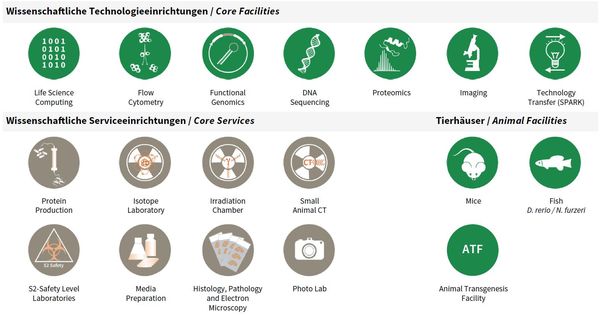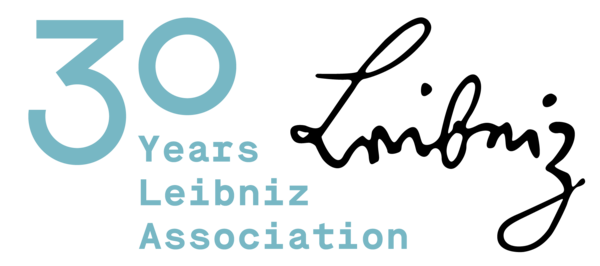Core Facilites and Core Services
At the beginning of 2016, a “core” structure was put into effect that organized facility and service units as independent organizational entities from FLI’s research groups. A number of technology platforms (e.g. sequencing, mass spectrometry) grew out of individual methodological requirements for single research groups in the last years but developed into semiautonomous substructures. As consequence of re-focused research activities and the concomitant advent of new research groups at FLI, those units increasingly had to serve many FLI groups and collaborative research efforts in the Jena research area.
To accommodate this development and to increase efficiency as well as transparency for users, facility personnel and for administrative processes, it came natural to re-organize such activities into independent units as “FLI Core Facilities and Services” and to phase out infrastructures considered non-essential for FLI’s research focus (X-ray crystallography and NMR spectroscopy).
FLI’s Core Facilities (CF) are managed by a CF Manager and are each scientifically guided in their activities and development by an FLI Group Leader, as Scientific Supervisor. The animal facilities comprising fish, mouse and transgenesis are run separately, as they involve a more complex organizational structure. Basic Core Services (CS) are directly led by the Head of Core (HC), who in turn is supported by individual CS Managers.
All facilities and services, including animal facilities, have a valuable contribution to FLI’s research articles; e.g. from 2016–2018, to 54% of all peer reviewed research publications.
Overview Core Facilities and Core Services at FLI.
Publications
(since 2016)
2024
- IER3IP1-mutations cause microcephaly by selective inhibition of ER-Golgi transport.
Anitei M, Bruno F, Valkova C, Dau T, Cirri E, Mestres I, Calegari F, Kaether C
Cell Mol Life Sci 2024, 81(1), 334 - Quantitative mapping of proteasome interactomes and substrates using ProteasomeID.
Bartolome A, Heiby* JC, Di Fraia* D, Heinze I, Knaudt H, Spaeth E, Omrani O, Minetti A, Hofmann M, Kirkpatrick JM, Dau** T, Ori** A
Elife 2024, 13, RP93256 * equal contribution, ** co-corresponding authors - Metabolic modeling reveals the aging-associated decline of host-microbiome metabolic interactions in mice
Best L, Dost T, Esser D, Flor S, Haase M, Kadibalban AS, Marinos G, Walker A, Zimmermann J, Simon R, Schmidt S, Taubenheim J, Künzel S, Häsler R, Groth M, Waschina S, W.Witte O, Schmitt-Kopplin P, F.Baines J, Frahm C, Kaleta C
bioRxiv 2024, https://doi.org/10.1101/2024.03. - Cilia defects upon loss of WDR4 are linked to proteasomal hyperactivity and ubiquitin shortage.
Burkhalter MD, Stiff T, Maerz LD, Casar Tena T, Wiese H, Gerhards J, Sailer SA, Vu LAT, Duong Phu M, Donow C, Alupei M, Iben S, Groth M, Wiese S, Church JA, Jeggo PA, Philipp M
Cell Death Dis 2024, 15(9), 660 - The Aging Synapse: An Integrated Proteomic And Transcriptomic Analysis
Caterino* C, Ugolini* M, Durso W, Jevdokimenko K, Groth M, Riege K, Görlach M, Fornasiero E, Ori A, Hoffmann S, Cellerino A
bioRxiv 2024, https://doi.org/10.1101/2024.12. * equal contribution - Optimized Automated Workflow for BioID Improves Reproducibility and Identification of Protein-Protein Interactions.
Cirri E, Knaudt H, Di Fraia D, Pömpner N, Rahnis N, Heinze I, Ori** A, Dau** T
J Proteome Res 2024, 23(10), 4359-68 ** co-corresponding authors - Amyloid beta precursor protein contributes to brain aging and learning decline in short-lived turquoise killifish (Nothobranchius furzeri)
E.M.de Bakker D, Mihaljević M, Gharat K, Richter Y, Bagnoli S, van Bebber F, Adam L, Shamim-Schulze F, Ohlenschläger O, Bens M, Cirri E, Antebi A, Matić I, Schneider A, Schmid B, Cellerino A, Kirstein J, Riccardo Valenzano D
bioRxiv 2024, https://doi.org/10.1101/2024.10. - Master corepressor inactivation through multivalent SLiM-induced polymerization mediated by the oncogene suppressor RAI2.
Goradia N, Werner S, Mullapudi E, Greimeier S, Bergmann L, Lang A, Mertens H, Węglarz A, Sander S, Chojnowski G, Wikman H, Ohlenschläger O, von Amsberg G, Pantel K, Wilmanns M
Nat Commun 2024, 15(1), 5241 - Impact of inflammatory preconditioning on murine microglial proteome response induced by focal ischemic brain injury.
Helbing DL, Haas F, Cirri E, Rahnis N, Dau TTD, Kelmer Sacramento E, Oraha N, Böhm L, Lajqi T, Fehringer P, Morrison H, Bauer R
Front Immunol 2024, 15, 1227355 - Denervation alters the secretome of myofibers and thereby affects muscle stem cell lineage progression and functionality.
Henze H, Hüttner SS, Koch P, Schüler SC, Groth M, von Eyss B, von Maltzahn J
NPJ Regen Med 2024, 9(1), 10









